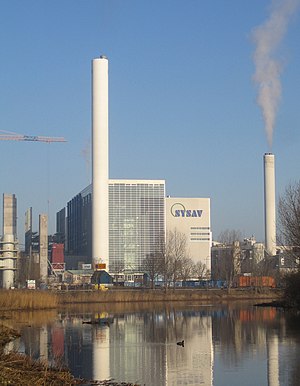 Image via Wikipedia
Image via WikipediaAfter writing about buying second hand goods, I got a few comments about giving to thrift stores, selling to stores like Crossroads, and having a garage sale to get rid of stuff instead of just throwing it away. After all, as I am sure you have heard many times by now, there is no ‘away.’ Or rather, ‘away’ is the ocean, landfills and incinerators.
‘Away’ is not so far away as you would like, and bits of what you throw away find their way back to you (like the mercury in seafood). The bits that don’t find their way back still might be affecting you in some other manner: by disrupting a food source, permanently damaging some piece of land, or being incinerated and mucking up your air.
There is a lot of waste in our society. For the identifiable past of ‘western civilization,’ we have always thought of things in terms of raw materials, useful products, and waste to be dealt with. But only in the past century and a half has the amount of waste been such a huge and universal problem. Today, we generate so much waste that even though we burn and bury the majority of it, it is clogging our streams, rivers, ports and even making a significant impact on every sea and ocean on the planet. If this were intentional, it would be quite an accomplishment. Unfortunately, it is a destructive and unintentional consequence of simply not paying enough attention to how much waste we generate and how we deal with it.
Now for the bad news: there is very little that you can do about it. At least by yourself, right now. You can recycle, and that is great. It really helps. Unfortunately, most things are not easily recyclable, and no municipality in this country has a 100% recycling rate for the things that are.
 Image via Wikipedia
Image via WikipediaYou can reuse stuff instead of throwing it away. You can (as mentioned above) sell or give old stuff away and buy other stuff second hand. This keeps stuff out of land fills and incinerator, and also reduces the need for manufacturing, packaging and shipping of more new stuff. But some things are never going to be available second hand, like food and cleaning products; nor should they be.
Finally, you can reduce the amount of stuff you buy. Maybe. Depending on the stuff. And you can consciously choose to buy stuff with less packaging. Sometimes. When there is an option. The fact is, the current paradigm embraces the old ‘raw materials, stuff, waste’ mind set wholeheartedly, and almost everything comes packaged in layers and layers of waste. And all that is not even the worst part, not by half.
The worst part is that before the stuff even got to the store, massive amounts of water and materials were turned into waste in the manufacturing process, and you as an individual right now have absolutely no power over that at all. Except...
There is one more thing that you can do that begins with ‘r,’ though it isn’t part of the traditional waste hierarchy: research. You can try to find out about the stuff you are buying, how it is produced, and vote with your dollars. So the good news is that we as the consumers (not individuals), over time (not right now), can try as often as possible to choose the less wasteful option, and that will make a difference. Because the more dollars that flow to low waste products, the more pressure there will be for a paradigm shift, from ‘materials, stuff, waste,’ to ‘materials, stuff, materials, stuff, materials...’ There is a growing field called industrial ecology that is preparing the new paradigm, and if we all push together, we can get this boulder rolling in their direction.

No comments:
Post a Comment